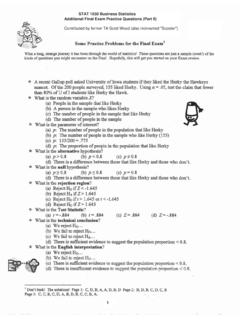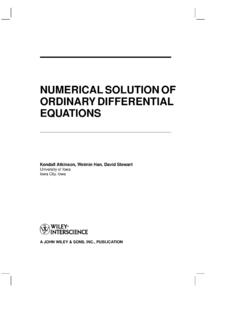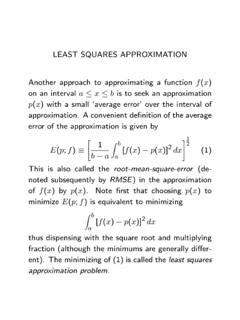Transcription of Biostatistics 22S:101 Answers to Practice Exam 2
1 Biostatistics 22S: 101 answers to practice exam 2 1. A large population contains an unknown proportion (p) of black marbles. A sample of n=200 drawn scientifically from the population contained x=40 black marbles. Which picture shows the posterior distribution of the population proportion p? Justify your answer. A. Because sep = sqrt(.2*.8/200) = .028 A. Looks like this ( = .2 and = .028) B. Looks like this ( = .2 and = .089) 2. An investigator wants to determine the proportion (p) of retirees who chose not to fill a prescription last year because it was too expensive. In a scientific sample of n=525, x = 98 respondents said that they had done this. State in words the posterior distribution of p. Obtain a 95% credible interval for p. What (approximately) is the probability that p exceeds .25 ? 95% CI: .153 to .220. P(p > .25 | data ) = (Area above z = ) = .0000. 3. A prospective study recruited 10,000 smokers and 10,000 non-smokers aged 30 to 39 and followed them for 20 years.
2 The cases of throat cancer are shown in this table. no Cancer Cancer Relative Frequency(%) Smokers 9800 200 Non-Smokers 9950 50 What is the estimated relative risk of throat cancer for smokers vs. non-smokers? mRR = = 4. Two hundred forty dieters volunteered for a study of chromium picolinate, a fat-reducing dietary supplement. They were randomly assigned to receive placebo or chromium picolinate. One side effect is reduction in iron, a key component of hemoglobin. Here are the data on percents of subjects with lower iron after 8 weeks of treatment. Placebo Chromium Picolinate n 120 120 % with reduced iron 16% 29% sep sed 95% CI What are the mean difference and the standard error of the difference (SED) between the percents?
3 Obtain a 95% credible interval for the difference. Is the difference statistically significant? Yes. 5. In a study to compare osteoporosis rates for men and women over the age of 70 it was observed that of 25000 men and 67% of 27000 women had osteoporosis. The difference is percentage points and the credible interval is to Is the difference significant? Yes, zero is ruled out. 6. In a randomized experiment, 400 kids brushed with baking powder and 400 brushed with toothpaste. 52 of the baking powder kids (13%) got cavities and 40 of the toothpaste kids (10%) got cavities. The difference is 3 percentage points. Obtain a 95% credible interval for the true difference. Is the difference significant? = .030, SED = .023 95% CI: to .0742 Not Significant. 7. An economic survey of a sample of 225 US wage earners showed an average of x=$ was spent per week eating out. The standard deviation of the sample was reported to be s = $ State the posterior distribution and obtain a 95% credible interval on the mean ( ) of all wage earners.
4 The posterior distribution is approximately normal with = x=$ , and = sem = 12/sqrt(225) = .80. The approximate 95% CI is + ; from to . 8. A random roadside survey of 481 males and 138 females found that 77 males and 16 females had detectable amounts of alcohol by a breathalyzer test. Is the difference significant? n 481 138 x 77 16 phat sep Dhat sed 95% CI Not Significant 9. R. M. Lyle, reported a study in which healthy men aged 45 to 65 received either a calcium supplement or a placebo for 12 weeks. He reported, "The calcium group had significantly lower blood pressure compared with the placebo group." (Note: blood pressure is measured in millimeters of mercury, abbreviated mm Hg.)
5 Which of the following sets of data is consistent with Lyle's statement? Why? A: Difference = 10 mm Hg with 95% credible interval to (Consistent rules out 0.) B: Difference = 20 mm Hg with 95% credible interval -5 to 45. 10. A sample drawn from a box of numbers with a fairly normal distribution has sample mean x = and sample standard deviation s = State the approximate posterior distribution of the box average ( box) a) if n=400 b) if n=36 a) Approximately normal with = and = b) Approximately t(35) with = and = 11. An unknown quantity, which we will call , has an approximately t(9) distribution with = and = Find the 95% credible interval for the unknown quantity. 95% Credible interval: + ; from to 12. One hundred male alcoholics suffering from secondary hypertension participated in a study to determine the efficacy of a new antihypertensive agent.
6 The men were assigned at random to either the control group or the treatment group. Men in the control group received a placebo. Statistics for arterial pressure at 30 days post treatment for the 97 subjects who completed the study are shown in this Table. Hypertension StudyPlacebo Treatmentn22 23 mean (x) standard deviation (s) State the approximate posterior distribution of the difference ( = Pbo Trt). The posterior distribution is: Approximately t( ) with = and = 95% Credible interval: to A B C 1 n 22 23 2 xbar 3 s 4 mu=xbar 5 sigma=sem 6 df=n-1 21 22 7 mu=deltaHat=b5-c5 8 sigma=sqrt(b6^2+c6^2) 9 df = B9^4/(B6^4/B7+C6^4/C7) 10 t(26) - percentile 11 95% CI Formulas ()()()()()()22124441212 1'ssemnppsepnsedsesesedSatterthwaite s dfsemsemdfdf= ==+=+







